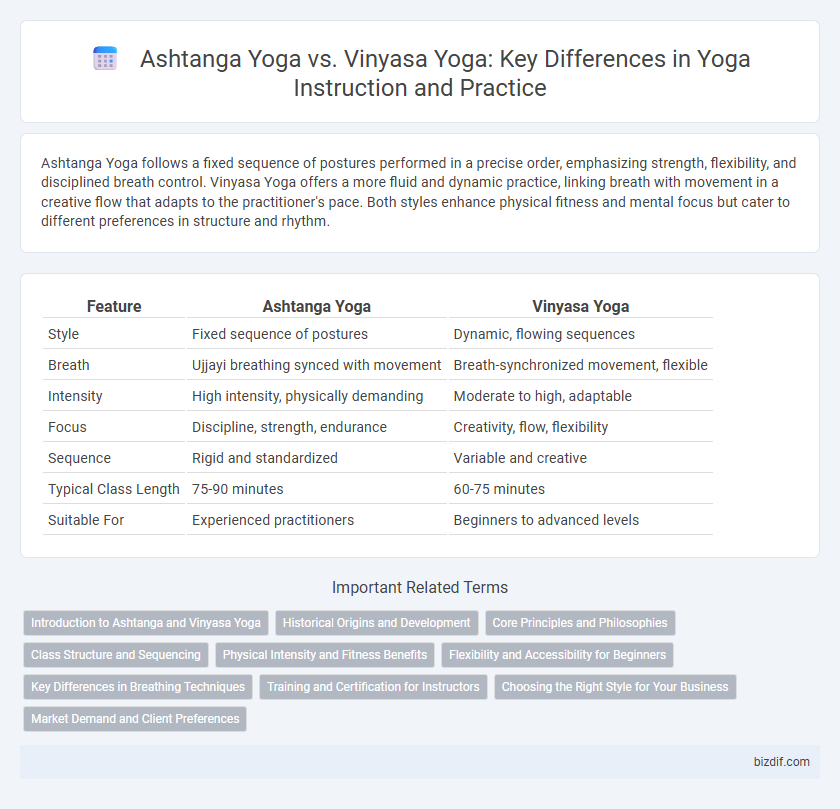Ashtanga Yoga follows a fixed sequence of postures performed in a precise order, emphasizing strength, flexibility, and disciplined breath control. Vinyasa Yoga offers a more fluid and dynamic practice, linking breath with movement in a creative flow that adapts to the practitioner's pace. Both styles enhance physical fitness and mental focus but cater to different preferences in structure and rhythm.
Table of Comparison
| Feature | Ashtanga Yoga | Vinyasa Yoga |
|---|---|---|
| Style | Fixed sequence of postures | Dynamic, flowing sequences |
| Breath | Ujjayi breathing synced with movement | Breath-synchronized movement, flexible |
| Intensity | High intensity, physically demanding | Moderate to high, adaptable |
| Focus | Discipline, strength, endurance | Creativity, flow, flexibility |
| Sequence | Rigid and standardized | Variable and creative |
| Typical Class Length | 75-90 minutes | 60-75 minutes |
| Suitable For | Experienced practitioners | Beginners to advanced levels |
Introduction to Ashtanga and Vinyasa Yoga
Ashtanga Yoga is a structured, dynamic practice consisting of six specific sequences that emphasize strength, flexibility, and breath-synchronized movement known as vinyasa. Vinyasa Yoga offers a more fluid and creative approach, connecting postures through continuous, flowing movements tailored to individual levels. Both styles enhance cardiovascular health, build stamina, and deepen breath awareness, making them complementary forms of yogic exercise.
Historical Origins and Development
Ashtanga Yoga, developed by K. Pattabhi Jois in the 20th century, traces its roots to the ancient teachings of T. Krishnamacharya and the Yoga Korunta text, emphasizing a fixed sequence of postures linked with breath. Vinyasa Yoga, evolving later as a more fluid and creative adaptation, derives from the same lineage but prioritizes synchronizing movement with breath in a dynamic and varied sequence. Both styles reflect the evolution of modern yoga practices, balancing tradition with contemporary practice innovations.
Core Principles and Philosophies
Ashtanga Yoga emphasizes a fixed sequence of postures combined with synchronized breathing, fostering discipline and internal heat generation for detoxification. Vinyasa Yoga prioritizes fluid movement connecting poses with breath, encouraging creativity and adaptability in practice. Both styles integrate breath control and mindfulness, yet Ashtanga roots itself in tradition while Vinyasa offers a more dynamic and varied approach.
Class Structure and Sequencing
Ashtanga Yoga follows a fixed sequence of postures structured into six series, emphasizing precise alignment and a consistent flow that builds strength and endurance. Vinyasa Yoga offers a more flexible class structure, where instructors creatively link poses in a flowing sequence varying by class, promoting adaptability and rhythm. Both styles synchronize breath with movement, but Ashtanga maintains strict sequences while Vinyasa encourages personalized expression within dynamic flow patterns.
Physical Intensity and Fitness Benefits
Ashtanga Yoga offers a structured, high-intensity practice characterized by a fixed sequence of poses that build strength, endurance, and cardiovascular fitness through continuous, flowing movements. Vinyasa Yoga provides a more dynamic and adaptable approach with variable sequences linking breath and movement, enhancing flexibility, balance, and muscular strength while promoting overall stamina. Both styles improve physical conditioning but differ in intensity and workout consistency, making Ashtanga ideal for disciplined fitness goals and Vinyasa suited for varied, full-body workouts.
Flexibility and Accessibility for Beginners
Ashtanga Yoga follows a fixed sequence of poses, promoting strength and flexibility but demanding discipline and prior experience, which may challenge beginners. Vinyasa Yoga offers a more fluid and varied practice, adapting pace and intensity to individual levels, making it more accessible for those new to yoga. Flexibility improves in both styles, yet Vinyasa's adaptable flow better supports gradual progress for novice practitioners.
Key Differences in Breathing Techniques
Ashtanga Yoga employs Ujjayi breathing, a deep, audible breath that synchronizes with a fixed sequence of postures to enhance focus and endurance. Vinyasa Yoga uses a more flexible breath pattern, coordinating inhales and exhales fluidly with varied poses, promoting dynamic flow and creative expression. The structured rhythmic breathing in Ashtanga contrasts with Vinyasa's adaptive breath approach, shaping distinct practice intensities and meditative qualities.
Training and Certification for Instructors
Ashtanga Yoga instructor training follows a structured, traditional approach emphasizing the precise sequencing of postures, often requiring immersive, intensive programs for certification. Vinyasa Yoga certification programs offer more flexibility, integrating diverse teaching styles and creative flow sequences tailored to individual instructor preferences. Both certifications typically demand comprehensive study of anatomy, philosophy, and teaching methodology to ensure proficient and safe instruction.
Choosing the Right Style for Your Business
Ashtanga Yoga emphasizes a rigorous, fixed sequence of poses promoting strength and discipline, ideal for studios targeting committed practitioners seeking structure and progression. Vinyasa Yoga offers fluid, creative sequencing that appeals to clients desiring variety and synchronization of movement with breath, making it suitable for dynamic classes and diverse skill levels. Selecting between Ashtanga and Vinyasa depends on your business goals, client preferences, and desired class atmosphere to maximize engagement and retention.
Market Demand and Client Preferences
Market demand for Vinyasa Yoga surpasses Ashtanga due to its dynamic flow and adaptability, attracting a broader clientele seeking varied intensity levels. Client preferences lean toward Vinyasa's flexibility in class structure, accommodating beginners and advanced practitioners alike, while Ashtanga appeals to dedicated yogis focused on traditional, rigorous sequences. Fitness studios report higher enrollment and retention rates in Vinyasa classes, driven by its contemporary style aligning with modern wellness trends.
Ashtanga Yoga vs Vinyasa Yoga Infographic

 bizdif.com
bizdif.com